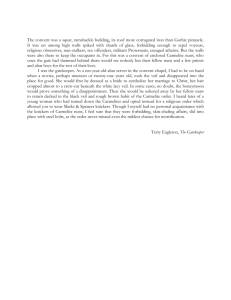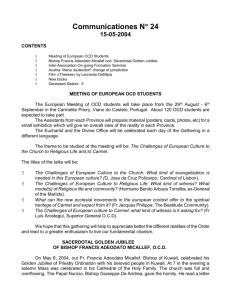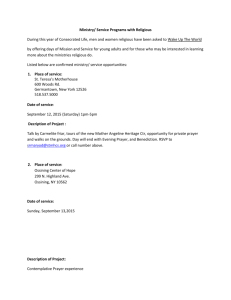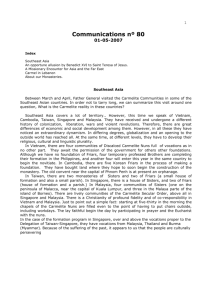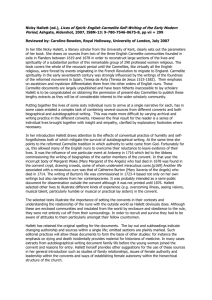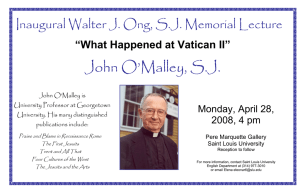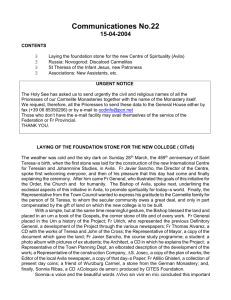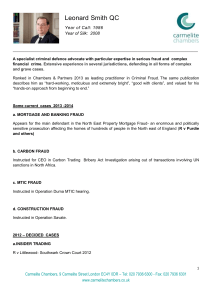John Malley - Carmelite Province of the Most Pure Heart of Mary
advertisement
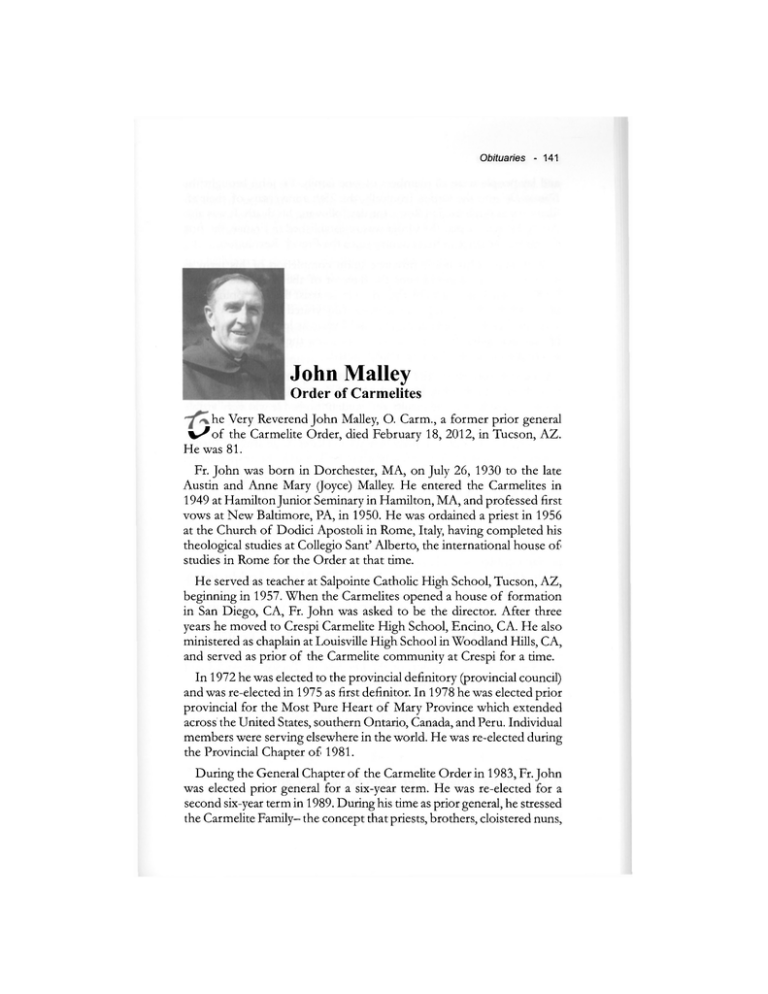
Obituaries - 141 John Malley Order of Carmelites he Very Reverend John Malley, O. Carm., a former prior general V ^ o f the Carmelite Order, died February 18, 2012, in Tucson, A Z . H e was 81. Fr. John was born in Dorchester, MA, on July 26, 1930 to the late Austin and Anne Mary (Joyce) Malley. H e entered the Carmelites in 1949 at Hamilton Junior Seminary in Hamilton, MA, and professed first vows at N e w Baltimore, PA, in 1950. H e was ordained a priest in 1956 at the Church of Dodici Apostoli in Rome, Italy, having completed his theological studies at Collegio Sant' Alberto, the international house of studies in Rome for the Order at that time. H e served as teacher at Salpointe Catholic High School, Tucson, A Z , beginning in 1957. When the Carmelites opened a house of formation in San Diego, CA, Fr. John was asked to be the director. After three years he moved to Crespi Carmelite High School, Encino, CA. H e also ministered as chaplain at Louisville High School in Woodland Hills, CA, and served as prior of the Carmelite community at Crespi for a time. In 1972 he was elected to the provincial definitory (provincial council) and was re-elected in 1975 as first definitor. In 1978 he was elected prior provincial for the Most Pure Heart of Mary Province which extended across'the United States, southern Ontario, Canada, and Peru. Individual members were serving elsewhere in the world. H e was re-elected during the Provincial Chapter of 1981. During the General Chapter of the Carmelite Order in 1983, Fr. John was elected prior general for a six-year term. He was re-elected for a second six-year term in 1989. During his time as prior general, he stressed the Carmelite Family— the concept that priests, brothers, cloistered nuns, 142 - The Sword and lay people were all members of one family. Fr. John brought the Donum Dei into the Order. Ironically, the 25th anniversary of their affiliation was celebrated in Rome the day following his death. It was also during his tenure that the Order was re-established in France, the first Carmelite presence in that country since the French Revolution. Returning to his home province upon completion of his term as prior general, Fr. John became the director of the Carmelite Mission Office, a fundraising arm of the province to assist the developing areas of the Order. Since Fr. John had personally visited nearly every house and member of the Order during his 12 years as leader of the Order, he was well suited for that ministry as he knew the needs of the areas where the Order had been recently planted. He also returned to the Carmelite community at Salpointe Catholic High School in Tucson. He worked in the school, providing a much needed presence for the faculty and student body. He was very visible at sporting events, plays, concerts, and parent gatherings at the school. He was noted for his handwritten notes and letters to an army of friends around the world, devoting a few hours most days to his correspondence. Fr. John is survived by two brothers, Edward William Malley and Fr. Vernon Malley, O. Carm., who also resided in the same Carmelite community as his brother for the past several years. Visitation was held at St. Cyril of Alexandria Church in Tucson on Thursday, February 23, 2012. A Mass of Christian burial took place at the same church on Friday, February 24. Interment immediately followed at Holy Hope Cemetery also in Tucson. The Mass was celebrated by the Most Rev. Fernando Millan Romeral, O. Carm., the current prior general of the Order. Two former priors general, Fr. Falco Tjhuis and Fr. Joseph Chalmers, were concelebrants along with Fr. John's brother, Vernon. Fr. Carl Markelz, the Carmelite provincial, and Fr. William J. Harry, Western commissary provincial, also concelebrated. The Most Rev. Gerald Kicanas, bishop of the Diocese of Tucson, presided and led the congregation in the final commendation. O n Tuesday, March 6, 2012, a Memorial Mass in honor of Fr. John took place in the evening at the Chapel of the National Shrine of Saint Therese on the Aylesford campus in Darien, IL. + + + Homily at the Funeral of Fr. John Malley, O. Carm. Probably each one of us has a litde different experience of Fr. John. For some he was member of the family—the uncle who came home Obituaries - 143 to Massachusetts during the summer and spent time on the Cape. For others of us, John was the prior of our community, our provincial, our prior general; he was a fellow member of our Carmelite province. For others he was a major supporter of their work on behalf of the Church's missions. For most perhaps, he was a familiar smiling figure in the hallways or patios of Salpointe, the school gym, or on the baseball diamond. H e was the one sitting in the back at a school play or musical concert. And for those of us who have gotten a little long in the tooth, he was our classroom religion teacher! But I find it interesting that lots of people will say "Fr. John taught m e " or "Fr. Randall taught me." But I have yet to hear one person talk about the actual content of those classes, the subject matter taught in those religion classes. And here is an important point for all of us who see ourselves as teachers. While no one talks about what John taught, they all talk about how John taught them. Everyone speaks very fondly and very gratefully of John's gentle presence, his ready smile, his encouraging word, the hand on the shoulder. That is the lesson they took from his class! That is what has proved important for them in later life. J o h n was never my classroom teacher, but he was very much my teacher. The man spent his life teaching each of us. I think his classroom was life itself, and the content of his lesson was that G o d has greatly blessed each and every one of us with abundant gifts . . . and that living life completely, fully, and without compromise, means we need to develop those gifts and use them, not for ourselves, but for others. John just loved people and he could never understand why people would keep God's gifts for themselves. All those gifts were to be used to build a better school, family, community, church, or world. And John did not just talk about this. His methodology was to teach by example. John never asked me to do something that he himself had not already done. Why did he live that way? Because he genuinely loved people! H e wanted us to succeed. H e wanted us to become better people. I suspect John was very much influenced by the passage Kate McGarey-Vasey just read from Paul's first letter to the Corinthians. When Paul wrote to the Corinthians, he was trying to get them to move beyond the status quo, from merely living life (often a self-centered life) to living a life centered on love. Paul points out to the Corinthians that they could have everything— the gift of prophecy, the ability to understand all of life's mysteries, a faith that could move mountains ... but if their lives were not based on love, if "love for other" was not their motivation for doing everything, than they had nothing at all. In fact, St. Paul says, " I f we live without love then we are nothing at all." 144 - The Sword A Friday morning Eucharistic celebration with the Salpointe varsity football team celebrated by Fr. John for many years in the chapel of the Carmelite monastery. (Photo courtesy of Salpointe Catholic High School) Then St. Paul goes on to describe what qualities love really is. We have all heard this passage many times but it bears repeating because this was at the heart of John's lesson. Paul writes that love is patient, kind, not easily angered, it keeps no record of wrong, it is not self-seeking. D o you catch what St. Paul is doing? H e is taking some ordinary characteristics of personal relationships—qualities that each of us is capable of possessing and Paul is saying " d o these ordinary things with love" and you will gain everything. Didn't Fr. John teach us this lesson of St. Paul's? Didn't John show us how to live these ordinary things with great love? Think back. In all the sporting events I attended with John, I never remember him raising his voice. Did you ever hear him yell? He accepted the victories and defeats with the same spirit. H e was even keeled as someone said last night. H e preferred winning to losing, no doubt about it. But he saw teachable moments in both. H e was there for all involved with his quiet, gentle, reassuring presence, the hand on the other person's shoulder, shaking the hands of the athletes after a victory or a defeat (It did not matter), giving each performer in the play an encouraging word. H e would use those events to teach us to accept graciously whatever comes our way. If we did not like the result then we could try harder next time, work together better. Or if we had tried our best, then it was possible to move on. Life would continue. We would be okay. You know besides never hearing John yell, I never saw him get mad. Obituaries - 145 One of handful of times I remember seeing him a little testy was when Fr. L e o McCarthy was visiting our community and kept using his cell phone at the dinner table. S o m e in the community—and they will remain nameless—found this slighdy inappropriate and so before the next evening meal, we printed up signs and hung them all around the monastery dining room, proclaiming it to be a cell phone free zone. Let me just say that what seemed like a very funny idea fell kind of flat. And as J o h n left the room after a slightly tense dinner, he turned around and just said " N o more signs." Even the man's fraternal corrections were gentle!! The Carmelite Family follows the Rule of St. Albert, a very short document ... 1600 words ... composed before 1214. When you read through this document, you realize that it is really taking the ordinary things of life—time management, silence, religious practices (Mass, group prayer, private prayer, meditation), relationships with another, even eating—these very ordinary things of daily life and making them the way that a person lives extraordinarily, that one actually becomes capable of encountering G o d face to face. It is in living the ordinary things of life extraordinarily with love that we come to know G o d . One artistic representation of our Rule was created by the Dutch artist Arie Trum. H e called it " N o Image Satisfies." What Trum did was arrange the 1600 words of the Rule in the shape of a cross. In the center of that cross is an empty space. To highlight the importance of this empty space, Trum made it into the most perfect of shapes, a circle. T h e n to give the empty circle even more importance, he highlighted it with a band o f pure gold. For me, this representation means that living life following the Rule of St. Albert will involve quite ordinary experiences. But most of life is very ordinary, and so it teaches us how to use those ordinary events and experiences that the Rule speaks o f — h o w we use time, silence, common religious practices, relationships with another, yes, even eating—to create this space within us, within our soul, in interior space that can only be filled by G o d ! Was not that really what Fr. John taught us? Fr. John's support and presence very often came in the form of a handwritten card or letter. H e had many friends, literally around the world. H e helped them and us navigate all those moments that normal, ordinary life brings, as well as some of the extraordinary ones, making sure we understood that he was there with us with his quiet, gende, reassuring letters—the theology of the note. How much more simple could it be! But how many of us treasure those notes and cards that we received from John! 146 - The Sword That is what the Rule of St. Albert and living as a Carmelite is all about. That is what the first reading, from the first book of Kings, is about. Elijah is attempting to experience G o d in the extraordinary—in the earthquake, in the fire, in the storm—but he does not find G o d in any of those. It is only when he feels this gentie breeze, or as some translations put it, in the sound of sheer silence, does Elijah realize that G o d is there with him. That silence, that gentle breeze is Elijah's encounter with G o d . G o d is not in the incredible events, not in the extraordinary. Elijah only finds G o d in the ordinary. Helping us to discover G o d in those ordinary events of our own lives was John's gift to so many of us. The Gospel passage from St. John was the only Scripture reading that Fr. J o h n specified he wanted read at his funeral. So obviously this Gospel had special meaning to him. It was also an important passage to St. Teresa of Avila, the 16th century Spanish Carmelite mystic, who Fr. John read and studied. Teresa never had direct access to this G o s pel passage as the Bible was only available in Latin in her day. But she became familiar with this passage in her spiritual reading, from authors who would quote the Scripture in Spanish. This particular passage had a tremendous influence on her writing " T h e Interior Castle" based on a direct, personal experience Teresa had of G o d — a n d how she understood her own faith journey, of going through the many rooms of the castle, ending with union with G o d . O f course, the goal, the vocation, the desire of each Christian is union with G o d — but the journey is arduous. While St. Teresa uses the image from Scripture of moving through this castle with many rooms, St. John of the Cross uses the image of ascending a mountain, and Carmelite spirituality also often speaks of the spiritual journey as a journey into the desert. We Tucsonians can perhaps relate best to that. The point is that we are all on this journey. I would not presume to judge where John Malley was in his own spiritual journey—that is between him and G o d . But it was obvious to me that there were two aspects to John's journey. While he was incredibly people oriented, he was also very reflective and prayerful—he worked at developing a personal relationship with his G o d . H o w appropriate that he died praying the office and that the book was open to the Psalm 116 which says, " H o w shall I make a return to the Lord for all the g o o d he has done for me? My vows to the Lord I will pay in the presence of all his people. Precious in the eyes of the Lord is the death of his faithful ones." When Fr. John was prior provincial, his secretary, Helen Sullivan often Obituaries - 147 referred to Fr. John—when he wasn't around—as St. John. When I went to Rome as a member of the General Council, John had completed his term of office six years before so he was well-known in Rome. I enjoyed making some statement and attributing it to "St. John." Someone would always get flustered and say, "That is from St. John? Where is that written in St. John?" Then someone familiar with my tactic would explain I was actually quoting John Malley. One day we were having a rather heated discussion about something when one of the Council members said "This was John Malley's doing when he was prior general. I told him it was wrong. He didn't listen! This is Malley's fault." And then, for his great finish, he pointed across the table at me and said "And T H I S O N E calls him St. John!!!" Everyone at the table dissolved into laughter. We all walked out of a very tense meeting laughing! To this day, the Spaniards who were there call me Este (This One). John was a very good man—no doubt about that. And the natural reaction is to want to memorialize him—a picture, something of concrete or metal. But I don't think John would be very interested in those kinds of memorials. Pictures fade. Concrete crumbles. Metal rusts. Plus John just did not like a lot of attention focused on himself. I think what Fr. John would be most interested in is a monument of flesh and blood. H e would want us to memorialize him by taking seriously all those things he taught us by his own example. He would want us to really live out authentically with our lives those lessons he taught us. Our best tribute to him would be to live life to the fullest, that we create space for G o d within us by making sure we take those little moments—being with each other, listening to one another, encouraging each other, connecting via letter or email (although he was not too keen on email himself), or one of the other ways John showed us how to love. He would ask that with our love we turn those very common, ordinary moments into great moments of love, genuine encounters with our God. That I think is the best, most lasting monument we could build to remember him. John, you good and faithful servant, enjoy living forever in the tender and loving presence of the Lord. And many thanks for all that you were for us. Amen. William J. Harry, O. Carm. Our Lady of Mount Carmel Priory Tucson, Arizona + + + 148 - The Sword Remarks of the Prior General at the Conclusion of the Mass As I said at the beginning of this celebration, Fr. John has been a very important person for our Carmelite Order. N o t only because he was our prior general for 12 years (from 1983 to 1995), but also because he had a big influence in our Order, especially, I would say, on my generation. I met him for the first time when I was a young Carmelite student in Seville, Spain, and he visited my province for the Provincial Chapter. He was, let us say, a "young mature" Carmelite, very gentle, always ready to listen and very fraternal. I also remember him on the occasion of the beatification of Titus Brandsma in Rome in 1985. That was a great moment for the whole Carmelite Family, and I think John really enjoyed those days in a very special way. You can't imagine how many emails and messages we have received from all over the world (Indonesia, Brazil, Rwanda, the Philippines, all parts of Europe...sisters, nuns, lay Carmelites, alumni of our schools, and many others) since his death. If I had to sum up the personality of John Malley as a Carmelite, I would underline three words (as he often did in his talks): 1) Love: John had a love for Carmel and for the Order. This is a common feeling among Carmelites I suppose. But John Malley did not love Carmel in a theoretical or abstract way. He loved the real Carmel. I use to say that we cannot love "ideal Carmel" (spirituality, mission, history, symbols, observance) if we don't love real Carmel (people with great values, with mistakes, with contradictions). And John loved the people. H e loved Carmel, and he loved Carmelites. As prior general, he was a very understanding man (perhaps for his background as a psychologist), generous in his service, close to the people, and encouraging. 2) Family: Fr. John's main idea during his time as prior general was, no doubt, the development of the "Carmelite Family." Probably he had a very good family experience in his personal background. This idea was already in the Constitutions of 1972, but John made this idea the main line of his service to the Order. Carmel is not only the friars, what we used to call the first Order. But Carmel is also the nuns, the sisters, the hermits, the lay people. The laity are linked with Carmel in a variety of ways: through the Third Order, Carmelite prayer groups, alumni of our schools, members of the Carmelite NGO's, and so on. In his time as prior general, John also intensified the contact with our Discalced Carmelite brethren and initiated the regular meetings and gatherings with their General Curia in Rome. Fr. Camilo Maccise was the Discalced general at that time. I am sure that the whole Carmelite family all around the world, Obituaries - 149 including the D i s c a l c e d , feel great sorrow these days because of John's death and yet are very thankful for his work in our Order. 3) Youth: John Malley was always very close to young people. I heard that the celebration in the school the day before yesterday was very impressive. H e developed and supported the "Carmelite youth" (Gioventu Carmelitana in Italy, Juventud Carmelita in Spain, Fr. Fernando Millan, the current prior general of and so on). H e was quite the Carmelite Order, speaks with Fr. John Malley, willing to talk and to listen prior general of the Order from 1983-1995, to young people. That is during the provincial chapter in 2008. why he stayed young, and he died young (watching the football and basketball matches, going to the mountains, driving long distances, and travelling around the world to support Carmelite missions and its social institutions). Age is not a number on our identity card or on our passport. Age is in our hearts. In the last decades we have been very fortunate with the men selected to be the priors general of our Order— I hope the trend does not change soon! Fr. Falco Thuis, as prior general, led the Order's renewal after the Second Vatican Council, a task which was not always easy. Fr. John Malley developed and supported the Carmelite Family, and Joseph Chalmers invited us to rediscover our contemplative dimension and charism. O f course, they did many other things as well. They are here today, a great tribute to our recent history indeed! I, as prior general of the Order, ask Our Lady of Mount Carmel, our Mother and Sister, to continue blessing and assisting us. I ask her, as Star of the Sea, to introduce our brother John into the tender and loving presence of God. Fernando Millan Romeral, O. Carm. Prior General Rome, Italy + + +
